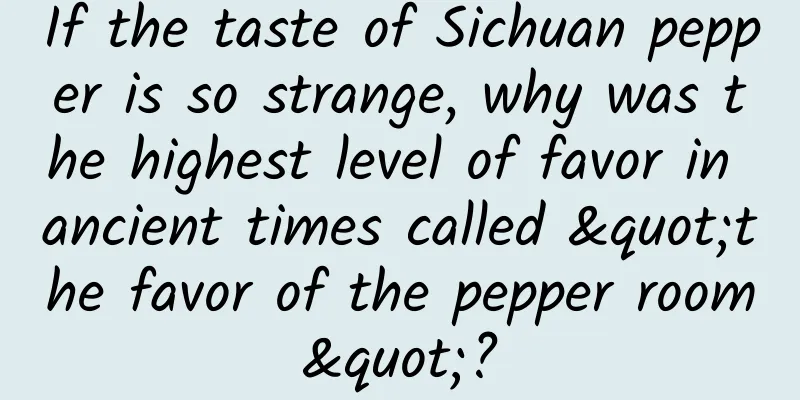If the taste of Sichuan pepper is so strange, why was the highest level of favor in ancient times called "the favor of the pepper room"?

|
People often say that only love and food are not to be missed, but it is a pity that "it is difficult to have both" is the norm in life. However, there is a plant that perfectly combines "love" and "food", and it is Sichuan pepper. As the first of the "Thirteen Spices" in Chinese condiments, the unique spicy flavor of Sichuan pepper adds a more layered flavor to many dishes. However, in addition to being a famous spice, Sichuan pepper also had many beautiful connotations in ancient times. For example, "The Book of Songs·Tang Feng·Pepper Liao" wrote: "The fruit of pepper Liao is abundant and full. The fruit of pepper Liao is huge and unparalleled. The fruit of pepper Liao is abundant and full. The fruit of pepper Liao is huge and unparalleled. The fruit of pepper Liao is abundant and full. The fruit of pepper Liao is huge and unparalleled. But you may ask, in China, there are also "chili peppers" and "peppers" that are closely related to our lives. How can we be sure that the "peppers" mentioned by the ancients are Sichuan peppers? How is "pepper" related to "love"? Let me explain it slowly. This pepper is not that pepper Pepper (Piper nigrum), which is common in daily life, is a perennial woody vine of the Piper family. As you can guess from the Chinese name, it is probably imported. According to the "Continued Book of Han" in the Western Jin Dynasty, "India produces rock honey, pepper, black salt..." Pepper was introduced to China from the Western Regions via the Silk Road. However, due to inconvenient transportation and scarce production, pepper has always been a precious exotic spice in ancient times. Pepper fruit (top, unripe; bottom, ripe) Image source: South China Botanical Garden, Chinese Academy of Sciences The chili pepper (Capsicum annuum), which is also commonly used in cooking, is a herbaceous plant of the Solanaceae family. It originated in Mexico across the ocean and was introduced to China in the late Ming Dynasty, when it was called "fan pepper". Chili peppers were first introduced as ornamental plants and were not gradually used as vegetables until the Qing Dynasty. Pepper fruit. Copyright image. Reproduction may cause copyright disputes. The protagonist of this article, Zanthoxylum bungeanum, is a deciduous small tree of the genus Zanthoxylum in the Rutaceae family. Compared with the above two, it is a genuine local species . According to the Flora of China, there are about 250 species of Zanthoxylum plants in the world, which are widely distributed in tropical and subtropical regions of Asia, Africa, Oceania, and North America, but relatively few in temperate zones. There are 39 species and 14 variants of Zanthoxylum bungeanum in China, which are distributed from the Liaodong Peninsula to Hainan Island, and from Taiwan to Tibet. Zanthoxylum bungeanum trees and fruits. Image source: Xunlu Lu Photography In 2015, Huang Yongjiang's team from the Kunming Institute of Botany, Chinese Academy of Sciences, discovered seed fossils of Zanthoxylum plants from different geological periods in Yunnan, the earliest of which can be traced back to 5 million years ago. This discovery has become strong evidence that Zanthoxylum originated in China, and we can also see from this that the "pepper" praised by the ancients during the Western Zhou Dynasty to the Spring and Autumn Period could only be Zanthoxylum. Zanthoxylum seed fossils found in Yunnan. Image source: Zhu hai et al. Continuous existence of Zanthoxylum (Rutaceae) in Southwest China since the Miocene[J]. QUATERNARY INTERNATIONAL, 2016, Vol.392 Pepper color If love had a color, it would definitely be as red as the fruit of Sichuan pepper. Although it is called "hua" pepper, the flowers of hua pepper are actually inconspicuous. Every March and April of the lunar calendar, small yellow-green cyme-shaped inflorescences grow on the thorny branches of the hua pepper tree. However, in autumn, these inconspicuous inflorescences will be covered with small red or purple fruits. The sight of the fruit-laden trees full of red and green has become the best symbol of love. Flowers and fruits of Zanthoxylum bungeanum. Image source: Xunlu Lu Photography The reason why Sichuan pepper is related to "love" is not only because of its fiery red color, but also because of its abundant fruits. In ancient times when science was not yet developed and productivity was very backward, humans were the most important labor force, so people regarded reproduction as the most important and sacred mission. As a result, humans consciously developed a devout primitive worship of the "fruitful" Sichuan pepper. "The fruits of Sichuan pepper are abundant and growing abundantly" (see "Tang Feng·Jiao Liao"), in fact, the ancestors expressed their yearning for the reproduction of their descendants and the prosperity of the population by praising the abundance of Sichuan pepper fruits. The abundant fruits of Sichuan pepper have become a beautiful testimony to the love of the ancients. Image source: Dong Fanrong The fiery red fruits of Sichuan peppercorns were also used to express love. "I regard you as a thorn, and you give me a handful of peppercorns." (See "Chen Feng Dongmen Zhiwu") describes the scene of young men and women meeting and exchanging gifts at that time: the man gave his lover a bunch of mallow flowers, and the woman gave her lover a bunch of fresh Sichuan peppercorns in return. The tender girl was not only willing to endure the pain of picking peppercorns, but also willing to give herself to you, to bear a bunch of children for you... willing to raise offspring with you... Even if a thousand years have passed, I am afraid there will never be a truer love than this. The fragrance of pepper If love has a scent, it must be as fragrant as the scent of pepper. As a member of the Rutaceae family, Sichuan peppercorns are naturally endowed with a distinctive smell. The aroma of Zanthoxylum bungeanum mainly comes from the volatile oils in the leaves and fruit cells of Zanthoxylum bungeanum, which are rich in many small molecule compounds, including olefins, ketones, alcohols, esters and epoxides, among which more than 300 have been confirmed by scientists. Because of its strong aroma, Sichuan pepper was first used as a spice for sacrifice. The Zhou Song Zai Shan records a blessing speech made by the Zhou people during a sacrifice after a good harvest: "The fragrance of Sichuan pepper brings glory to the country. The fragrance of Sichuan pepper brings peace to the country..." This means that Sichuan pepper was used as a tribute to sacrifice to ancestors in order to pray for health, longevity, and peace for the country and the people. In addition to being used for sacrificial ceremonies, the ancients also believed that the aroma of Sichuan pepper could both refresh the mind and please the body and mind, and that it had the same "gentlemanly qualities" as orchids. "Xunzi" records: "Pepper and orchid are fragrant and refreshing, and are good for the nose." In addition to offering sacrifices, the ancients believed that the fragrance of pepper can both refresh the mind and make the body and mind happy, and it has the same gentleman's appearance as orchids. Therefore, it is also used as a spice to fill sachets. In the Mawangdui No. 1 Han Dynasty Tomb in Changsha, pepper was found in the sachets and embroidered pillows in the hands of the tomb owner, which shows that people loved the fragrance of pepper at that time. Sichuan peppercorns can not only be made into sachets and worn on the body, but the clever ancients also used its fragrance to improve the flavor of food. Before the Tang and Song dynasties, due to the imperfect wine-making technology, people mostly drank turbid rice wine, which was called "jiang" (similar to the yellow wine people drink today). But people found that adding a little peppercorns to rice wine can significantly enhance the flavor and taste of the wine. Qu Yuan wrote in Nine Songs: "Orchid dishes are steamed on the orchid mat, and cinnamon wine and pepper juice are served." Since then, "cinnamon wine and pepper juice" has become a synonym for fine wine in the writings of literati and poets. "Who will wear the colorful hairpins on the pepper plate, spend their youth, and compete for the spring breeze on their temples?" (Xin Qiji's Butterfly Loves Flowers) Look, even the container used to hold pepper when drinking has been given an elegant name by the poet. Although the fragrance of Sichuan pepper leaves is not as strong as that of the fruit, it is not wasted. In the early spring in northern China, people often use the young leaves of Sichuan pepper to make pancakes or steamed buns . The method is to crush the young leaves of Sichuan pepper and mix them with fermented flour to make pasta and steam it. The fragrance of pepper leaves mixed with carbohydrates is the best taste in the world. The abundance of fruits symbolizes the prosperity of offspring; the sweet smell represents long-lasting happiness. In addition to eating and drinking, the clever Chinese also invented the world's most "wife-pampering" building - the pepper room , taking advantage of the characteristics of pepper. The so-called pepper room is to crush the fruits of Sichuan pepper and mix them with lime into a paste, which is then applied to the walls. Since the ripe fruits of Sichuan pepper are used, the color of the paste is red to light purple, which makes the indoor walls fragrant and colorful, and also implies the prosperity of offspring, which is really killing three birds with one stone. But in ancient times, such a house was a luxury that only the royal family and nobles could enjoy. For example, in the Han Dynasty, the Pepper Room in the Weiyang Palace was the exclusive bedroom of the empress, as described in the poem "The Ming Concubine is the most graceful, and she should be in the Pepper Room with four stars" (Bai Juyi's "Zhaojun Yuan"). After the Wei and Jin Dynasties, "Pepper Room" was used to refer to the emperor's most beloved woman, and the competition for "Pepper Room's Favor" in the harem has become an indispensable plot in the palace fighting dramas that dominate the screen today. The flavor of pepper If love has a taste, it must be as spicy as Sichuan pepper. In the era when pepper was not yet popular, Sichuan pepper, dogwood and ginger have always been the main spicy seasonings used in folk cooking. Even the great poet Bai Juyi could not help but praise the food after tasting his wife's cooking: "It is served with dried meat and salted fish (hǎi), and interspersed with the fragrance of pepper and scallion (xiè)." In addition, "spicy, fresh and fragrant" is the top understanding and love of Sichuan cuisine, and the top "numbing" is all due to Sichuan pepper. The compounds that make up the numbing taste of Sichuan pepper are mainly a series of amide substances , including more than 20 chain unsaturated fatty acid amides such as sanshool, all of which are highly irritating, and these substances are mainly distributed in the seed coat of Sichuan pepper fruit. In addition to its unique flavor, modern research has also found that these numbing substances have a variety of physiologically active effects. In fact, since the Han Dynasty, the ancients have had a clear understanding of the medicinal value of peppercorns. "Shennong's Herbal Classic" records that peppercorns have the effects of "strengthening teeth and hair", "anti-aging", and "increasing longevity". In the Ming Dynasty, Li Shizhen's "Compendium of Materia Medica" recorded the medicinal value of peppercorns in more detail: "Peppercorns are pure yang things, their taste is spicy and numbing, and their temperature is hot... It can dispel cold and dampness, relieve depression, eliminate food stagnation, clear the three burners, warm the spleen and stomach, replenish the right kidney gate, kill roundworms, and stop diarrhea." The seeds of Sichuan pepper are shiny black and are called pepper eyes. In traditional medicine, they are used to promote diuresis and reduce swelling, and to eliminate phlegm and relieve asthma. Image source: Dong Fanrong The numbing content and taste of pepper peel are closely related to the place of origin and variety. Since ancient times, the largest pepper production areas in China are Shaanxi and Sichuan, so the ancients named them Qin pepper and Shu pepper. In terms of variety, the main domestic varieties are Dahongpao and Qinghua pepper, in addition to Zhenglu pepper, Gou pepper, and Tengjiao (also known as bamboo leaf pepper). Gourmets from all over the country have also adapted to local conditions and used local peppercorns to create countless special foods with local flavors. Xinjiang's pepper and sesame chicken, Sichuan and Chongqing's spicy hot pot, Jiangsu and Zhejiang's pepper and salt spare ribs, Hunan's green pepper fish, etc. have now become household street foods. Sichuan pepper has nourished the Chinese people for thousands of years with its unique romantic connotation and attractive color, aroma and taste, and has also given rise to many brilliant cultures on the Chinese land. Two thousand years have passed, and the entanglement between plants and humans is still going on every day. If you want to enjoy both your lover and delicious food, take him/her to eat a meal full of peppercorns. Let love and this spicy heat be even more intense!!! Acknowledgements: We would like to thank Mr. Xun Lulu from Xi’an Botanical Garden, Shaanxi Province and his good friend Dong Fanrong for providing a large number of precious photos and valuable suggestions for writing this article. References [1] Flora of China Mobile Edition [2]Zhu hai et al. Continuous existence of Zanthoxylum (Rutaceae) in Southwest China since the Miocene[J]. QUATERNARY INTERNATIONAL, 2016, Vol.392 [3] Cao Yin et al. Complete Tang Poems[M]. Beijing: Zhonghua Book Company, 2013 [4] Wang Yueqiu et al. Research on the composition and detection technology of Zanthoxylum bungeanum[J]. Shandong Chemical Industry, 2018, 47(20) [5] Li Wei. Research progress on aroma components analysis in Zanthoxylum bungeanum[J]. Chinese Food Additives, 2021, 192(12) [6] Zhao Zhenzhong et al. Zanthoxylum bungeanum[J]. Life World, 2022, 09 [7] Wu Qijun. A Survey of Plant Names and Illustrations[M]. Beijing: Zhonghua Book Company, 2018. [8] Lu Ji. Mao Shi: Plants, Birds, Beasts, Insects and Fishes, Beijing: Zhonghua Book Company, 1985. [9] Kan Jianquan et al. Research progress on the physiological effects of pepper numbing substances [J]. Journal of Food Science and Technology, 2018, 36(01) 10. Guo Xiaohong et al. Research progress on the nutritional value and storage and preservation technology of pepper [J]. China Fruit and Vegetable, 2022, 42(08) Planning and production Produced by Science Popularization China Author: Li Bo, Shaanxi Institute of Biological Agriculture Producer丨China Science Expo Editor: Yang Yaping Proofread by Xu Lailinlin |
Recommend
Why is the Okolin electric toothbrush not worth buying?
Recently, there have been more and more publicity...
What is the most cost-effective way to bid for keywords? How to bid for keywords?
For those who do bidding promotion, they are all ...
Mobile APP and game promotion, why can’t we achieve significant results even though we have a budget?
Many people may not understand that in operations...
South Korea added 147 new confirmed cases of COVID-19 yesterday, bringing the total to 8,799!
[South Korea added 147 new confirmed cases of COV...
New gameplay! What can iPhone 6s do with Force Touch?
Force Touch technology has been successfully appl...
Why can’t we retain new users? Here are 4 best solutions
Why is it that even though we have been attractin...
Why do only Chinese people like to drink hot water? Is "drinking more hot water" really useful?
Drinking hot water seems to be a tradition deeply...
It's as smooth as iOS and as stable as Android, so why doesn't anyone use it?
Among the world's three major mobile operatin...
What should I do if I want to quickly sell Didi’s friend links?
Click Sell Friendly Links → My Website page, clic...
"Soft-hearted" consumption! Why are we easily sold?
Being a qualified salesperson is definitely a tec...
What is the experience of using a 64GB computer? It feels like it will take off
Since March 2016, due to the shortage of flash me...
One year after Huang Zhang’s comeback: Meizu’s de-familyization revolution
As the founder and soul of the company, Huang Zha...
These 3 types of people are really not suitable for naps! Check if it’s you
Spring sleepiness, summer fatigue, autumn naps, a...
Local service promotion sideline, precise traffic monetization project
In the past few days, I have talked a lot about l...
AMG GT family to be officially unveiled in 2017
At the Los Angeles Auto Show, Mercedes-AMG offici...









